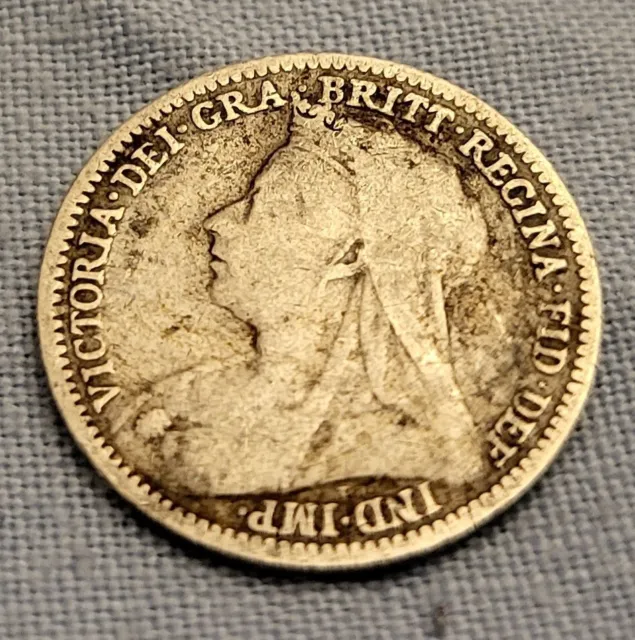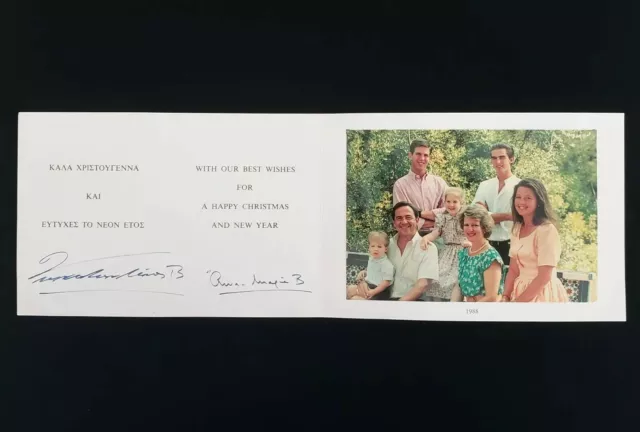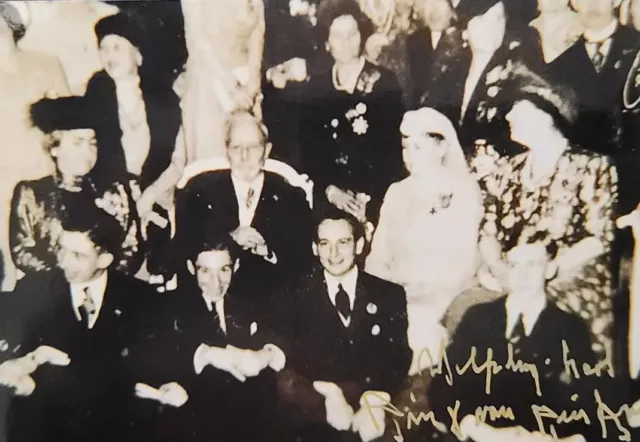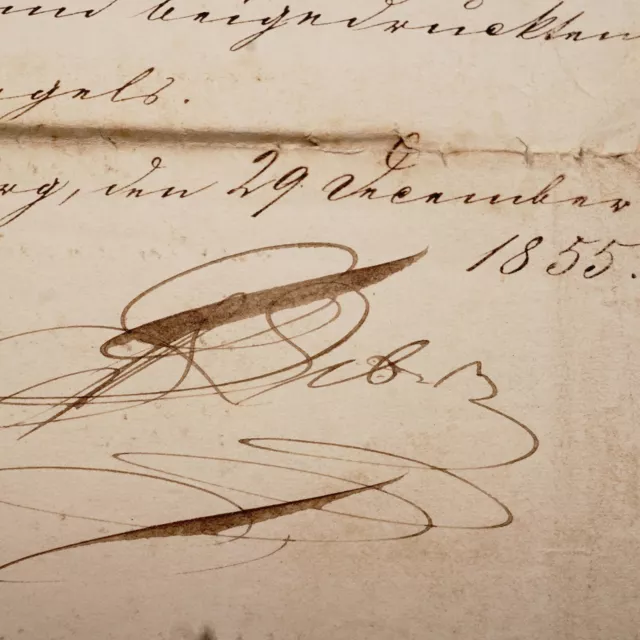Royalty King William Frederick IV Wilhelm Peter II German Royal Document Signed
For your consideration is a rare and important royal manuscript document hand-signed by King Frederick William IV of Prussia's private secretary. OLDENBURG: Royal document Peter II from c.1855. Extremely scarce. Bearing large intact paper and royal wax seal with coat of arms.
Frederick William IV (German: Friedrich Wilhelm IV.; 15 October 1795[3] – 2 January 1861), the eldest son and successor of Frederick William III of Prussia, reigned as King of Prussia from 7 June 1840 to his death. Also referred to as the "romanticist on the throne", he is best remembered for the many buildings he had constructed in Berlin and Potsdam, as well as for the completion of the Gothic Cologne Cathedral.
In politics, he was a conservative, who initially pursued a moderate policy of easing press censorship and reconciling with the Catholic population of the kingdom. During the German revolutions of 1848–1849, he at first accommodated the revolutionaries but rejected the title of Emperor of the Germans offered by the Frankfurt Parliament in 1849 as not the Parliament's to give and used military force to crush the revolutionaries throughout the German Confederation. From 1849 onward he converted Prussia into a constitutional monarchy and acquired the port of Wilhelmshaven in the Jade Treaty of 1853.
From 1857 to 1861, he suffered several strokes and was left incapacitated until his death. His brother (and heir-presumptive) Wilhelm served as regent after 1858 and then succeeded him as King.
Born to Frederick William III by his wife Queen Louise, he was her favourite son.[3] Frederick William was educated by private tutors, many of whom were experienced civil servants, such as Friedrich Ancillon.[3] He also gained military experience by serving in the Prussian Army during the War of Liberation against Napoleon in 1814, although he was an indifferent soldier. He was a draftsman interested in both architecture and landscape gardening and was a patron of several great German artists, including architect Karl Friedrich Schinkel and composer Felix Mendelssohn. In 1823 he married Elisabeth Ludovika of Bavaria. Since she was a Roman Catholic, the preparations for this marriage included difficult negotiations which ended with her conversion to Lutheranism. There were two wedding ceremonies—one in Munich, and another in Berlin. The couple had a very harmonious marriage, but it remained childless.
Frederick William was a staunch Romanticist, and his devotion to this movement, which in the German States featured nostalgia for the Middle Ages, was largely responsible for his developing into a conservative at an early age. In 1815, when he was only twenty, the crown prince exerted his influence to structure the proposed new constitution of 1815, which was never actually enacted, in such a way that the landed aristocracy would hold the greatest power. He was firmly against the liberalization of Germany and only aspired to unify its many states within what he viewed as a historically legitimate framework, inspired by the ancient laws and customs of the recently dissolved Holy Roman Empire. Frederick William opposed the idea of a unified German state, believing that Austria was divinely ordained to rule over Germany,[citation needed] and contented himself with the title of "Grand General of the Realm".
Frederick William became King of Prussia on the death of his father in 1840. Through a personal union, he also became the sovereign prince of the Principality of Neuchâtel (1840–1857), today part of Switzerland. In 1842, he gave his father's menagerie at Pfaueninsel to the new Berlin Zoo, which opened its gates in 1844 as the first of its kind in Germany. Other projects during his reign—often involving his close collaboration with the architects—included the Alte Nationalgalerie (Old National Gallery) and the Neues Museum in Berlin, the Orangerieschloss at Potsdam as well as the reconstruction of Schloss Stolzenfels on the Rhine (Prussian since 1815) and Burg Hohenzollern, in the ancestral homelands of the dynasty which became part of Prussia in 1850. He also enlarged and redecorated his father's Erdmannsdorf manor house.
Although a staunch conservative, Frederick William did not seek to be a despot, and so he toned down the reactionary policies pursued by his father, easing press censorship and promising to enact a constitution at some point, but he refused to create an elected legislative assembly, preferring to work with the nobility through "united committees" of the provincial estates. Despite being a devout Lutheran, his Romantic leanings led him to settle the Cologne church conflict by releasing the imprisoned Clemens August von Droste-Vischering, the Archbishop of Cologne. He also patronized further construction of Cologne Cathedral, Cologne having become part of Prussia in 1815. In 1844, he attended the celebrations marking the completion of the cathedral, becoming the first King of Prussia to enter a Roman Catholic house of worship. When he finally called a national assembly in 1847, it was not a representative body, but rather a United Diet comprising all the provincial estates, which had the right to levy taxes and take out loans, but no right to meet at regular intervals.
When revolution broke out in Prussia in March 1848, part of the larger series of Revolutions of 1848, the king initially moved to repress it with the army, but on 19 March he decided to recall the troops and place himself at the head of the movement. He committed himself to German unification, formed a liberal government, convened a national assembly, and ordered that a constitution be drawn up. Once his position was more secure again, however, he quickly had the army reoccupy Berlin and in December dissolved the assembly. He did, however, remain dedicated to unification for a time, leading the Frankfurt Parliament to offer him the crown of Germany on 3 April 1849, which he refused, purportedly saying that he would not accept "a crown from the gutter". The King's refusal was rooted in his Romantic aspiration to re-establish the medieval Holy Roman Empire, comprising smaller, semi-sovereign monarchies under the limited authority of a Habsburg emperor. Therefore, Frederick William would only accept the imperial crown after being elected by the German princes, as per the former empire's ancient customs. He expressed this sentiment in a letter to his sister the Empress Alexandra Feodorovna of Russia, in which he said the Frankfurt Parliament had overlooked that "in order to give, you would first of all have to be in possession of something that can be given. "In the king's eyes, only a reconstituted College of Electors could possess such authority. With the failed attempt by the Frankfurt Parliament to include the Habsburgs in a newly unified German Empire, the Parliament turned to Prussia. Seeing Austrian ambivalence towards Prussia taking a more powerful role in German affairs, Frederick William began considering a Prussian-led union. All German states, excluding those of the Habsburgs, would be unified under Hohenzollern authority, and these two polities would be linked in an overarching political framework.[8] Frederick William, therefore, did attempt to establish the Erfurt Union, a union of the German states except for Austria, but abandoned the idea by the Punctation of Olmütz on 29 November 1850, in the face of renewed Austrian and Russian resistance. The German Confederation remained the common government of German Europe.
Rather than returning to bureaucratic rule after dismissing the Prussian National Assembly, Frederick William promulgated a new constitution that created a Parliament of Prussia with two chambers, an aristocratic upper house and an elected lower house. The lower house was elected by all taxpayers, but in a three-tiered system based on the amount of taxes paid, so that true universal suffrage was denied. The constitution also reserved to the king the power of appointing all ministers, re-established the conservative district assemblies and provincial diets, and guaranteed that the civil service and the military remained firmly under control of the king. This was a more liberal system than had existed in Prussia before 1848, but it was still a conservative system of government in which the monarch, the aristocracy, and the military retained most of the power. This constitution remained in effect until the dissolution of the Prussian kingdom in 1918.
Prussia (/ˈprʌʃə/; German: Preußen, pronounced [ˈpʁɔʏsn̩] (About this soundlisten), Old Prussian: Prūsa or Prūsija) was a historically prominent German state that originated in 1525 with a duchy centered on the region of Prussia on the southeast coast of the Baltic Sea. It was de facto dissolved by an emergency decree transferring powers of the Prussian government to German Chancellor Franz von Papen in 1932 and de jure by an Allied decree in 1947. For centuries, the House of Hohenzollern ruled Prussia, successfully expanding its size by way of an unusually well-organised and effective army. Prussia, with its capital first in Königsberg and then, in 1701, in Berlin, decisively shaped the history of Germany.
In 1871, most German states (notably excluding Austria and Switzerland) united to create the German Empire under Prussian leadership. In November 1918, the monarchies were abolished and the nobility lost its political power during the German Revolution of 1918–19. The Kingdom of Prussia was thus abolished in favour of a republic—the Free State of Prussia, a state of Germany from 1918 until 1933. From 1933, Prussia lost its independence as a result of the Prussian coup, when the Nazi regime was successfully establishing its Gleichschaltung laws in pursuit of a unitary state. With the end of the Nazi regime, in 1945, the division of Germany into Allied occupation zones and the separation of its territories east of the Oder–Neisse line, which were incorporated into Poland and the Soviet Union, the State of Prussia ceased to exist de facto. Prussia existed de jure until its formal abolition by the Allied Control Council Enactment No. 46 of 25 February 1947.
The name Prussia derives from the Old Prussians; in the 13th century, the Teutonic Knights—an organized Catholic medieval military order of German crusaders—conquered the lands inhabited by them. In 1308, the Teutonic Knights conquered the region of Pomerelia with Gdańsk (Danzig). Their monastic state was mostly Germanised through immigration from central and western Germany, and, in the south, it was Polonised by settlers from Masovia. The Second Peace of Thorn (1466) split Prussia into the western Royal Prussia, a province of Poland, and the eastern part, from 1525 called the Duchy of Prussia, a fief of the Crown of Poland up to 1657. The union of Brandenburg and the Duchy of Prussia in 1618 led to the proclamation of the Kingdom of Prussia in 1701.
Prussia entered the ranks of the great powers shortly after becoming a kingdom, and exercised most influence in the 18th and 19th centuries. During the 18th century it had a major leverage in many international affairs under the reign of Frederick the Great. During the 19th century Prussian Chancellor Otto von Bismarck united the German principalities into a "Lesser Germany", which excluded the Austrian Empire.
At the Congress of Vienna (1814–15), which redrew the map of Europe following Napoleon's defeat, Prussia acquired rich new territories, including the coal-rich Ruhr. The country then grew rapidly in influence economically and politically, and became the core of the North German Confederation in 1867, and then of the German Empire in 1871. The Kingdom of Prussia was now so large and so dominant in the new Germany that Junkers and other Prussian élites identified more and more as Germans and less as Prussians.
The Kingdom ended in 1918 along with other German monarchies that collapsed as a result of the German Revolution. In the Weimar Republic, the Free State of Prussia lost nearly all of its legal and political importance following the 1932 coup led by Franz von Papen. Subsequently, it was effectively dismantled into Nazi German Gaue in 1935. Nevertheless, some Prussian ministries were kept and Hermann Göring remained in his role as Minister President of Prussia until the end of World War II. Former eastern territories of Germany that made up a significant part of Prussia lost the majority of their German population after 1945 as the People's Republic of Poland and the Soviet Union both absorbed these territories and had most of its German inhabitants expelled by 1950. Prussia, deemed a bearer of militarism and reaction by the Allies, was officially abolished by an Allied declaration in 1947. The international status of the former eastern territories of Germany was disputed until the Treaty on the Final Settlement with Respect to Germany in 1990, while its return to Germany remains a topic among far right politicians, the Federation of Expellees and various political revisionists.
The term Prussian has often been used, especially outside Germany, to emphasize professionalism, aggressiveness, militarism and conservatism of the Junker class of landed aristocrats in the East who dominated first Prussia and then the German Empire.
- Condition: Used
- Country: Germany
- Country/Region of Manufacture: Germany
- Features: Antique, Illustrated, Official Release
- Royal: Friedrich Wilhelm
- Royalty: Bavaria
- Signed: Yes
- Theme: Royalty
- To Commemorate: Coronation
- Type: Royal Document
- Vintage: Yes
- Modified Item: Yes
- Modification Description: Hand-signed by Frederick IV
PicClick Insights - Royalty King William Frederick IV Wilhelm Peter II German Royal Document Signed PicClick Exclusive
- Popularity - 0 watchers, 0.0 new watchers per day, 43 days for sale on eBay. 0 sold, 1 available.
- Best Price -
- Seller - 1,230+ items sold. 0% negative feedback. Great seller with very good positive feedback and over 50 ratings.
People Also Loved PicClick Exclusive

Vintage Photo German Emperor Kaiser Wilhelm Ii Signed Royalty
$31.75 3 Bids 2d 9h
SOLID SILVER Old Three pence Coin 1900 Proof Queen Victoria Sterling 3D London
$4.24 6 Bids 5d 5h
Rare Greek Royalty Card Royal Document Signed King Constantine II Queen Greece
$272.48 Buy It Now 18d 0h
Prussian Prince Wilhelm Signed Royal Presentation Photo Document German Royalty
$545.04 Buy It Now 18d 0h
Rare 1848 Royal HRH Prince Ludwig II Grand Duke Signed Document German Royalty
$613.17 Buy It Now 18d 1h
Historical Tokens Exonumia King William IV 1831 - 1837
$38.18 Buy It Now
WILLIAM RUFUS / KING WILLIAM II PORTRAIT C1890 Magic Lantern Slide ROYALTY
$31.81 Buy It Now 1 watcher
1 watcher1691 William III & Mary II Historical Token Medal
$38.18 Buy It Now or Best Offer
Type Card. Royalty King William II
$4.99 Buy It Now


